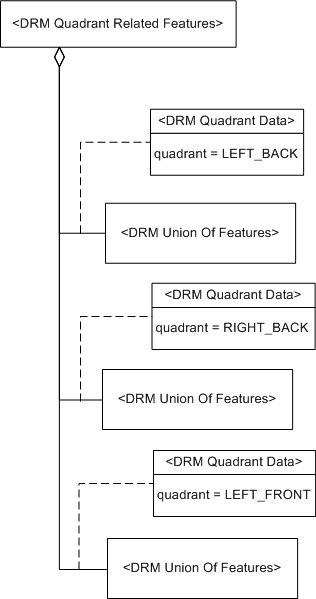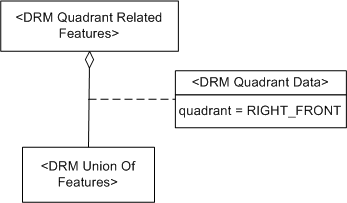Class Name: Quadrant Related Features
Subclasses
This DRM class is concrete and has no subclasses.
Definition
An instance of this DRM class specifies an aggregation of
<Feature Hierarchy> components
in which each <Feature Hierarchy> component
represents a branch of a quadrant. The quadrant represented by a branch is
specified by the <Quadrant Data> link object associated
with that branch. The bounding region that the
<Feature Hierarchy> components occupy is
defined by the <Spatial Extent> component of the
<Quadrant Related Features> instance.
Primary Page in DRM Diagram:
Secondary Pages in DRM Diagram:
This class appears on only one page of the DRM class diagram.
Example
Consider a region of terrain that is organized into quadrants, where the
SE_QUADRANT_RIGHT_FRONT
quadrant consists of ocean, and the other three quadrants
consist of the terrain bordering the ocean. The ocean quadrant is not
represented in the producer's system. The region is represented in the DRM
by a <Quadrant Related Features>
instance with three <Union Of Features>
components as depicted in Figure 49.
Since the remaining quadrant had no
<Feature Representation> instances,
it is not represented.

Figure 49 — <DRM Quadrant Related Features> ocean example
Consider a
<Quadrant Related Features> instance
linked to a <Union Of Features> instance
representing its
SE_QUADRANT_RIGHT_FRONT
quadrant, using a
<Quadrant Data> link object. The
<Quadrant Data> link object's
quadrant value is
SE_QUADRANT_RIGHT_FRONT
as depicted in Figure 50

Figure 50 — <DRM Quadrant Related Features> example
FAQs
-
If a
<Quadrant Related Features> instance
has less than four components, why is the data being represented using a
<Quadrant Related Features> instance
at all?
A
<Quadrant Related Features> instance
is used when the environmental data to be represented logically lends
itself to a quadrant related organization. However, since a given quadrant
within such an organization might not contain
<Primitive Feature> instances, a
<Quadrant Related Features> instance
can have fewer than four components.
-
Where is the <Spatial Extent> component?
A
<Quadrant Related Features> instance
automatically has a <Spatial Extent> component,
because it is a
<Feature Hierarchy> instance.
Constraints
Associated to (one-way) (inherited)
Associated by (one-way) (inherited)
Composed of (two-way) (inherited)
Composed of (two-way)
Composed of (two-way metadata) (inherited)
Component of (two-way) (inherited)
Notes
Associated to Notes
An association between two
<Feature Representation> instances
indicates that the environmental object(s) that they
represent have the semantic relationship indicated by
the <Base Association Data>
link object on the association relationship.
An association between a
<Geometry Hierarchy> instance and a
<Feature Representation> instance
indicates that the environmental object(s) that they
represent have the semantic relationship indicated by
the <Base Association Data>
link object on the association relationship.
An association between a
<Property Grid> instance and a
<Feature Representation> instance
indicates that the environmental object(s) represented by the
<Feature Representation> instance
and the <Property Grid> instance
(or some specific cell data within that
<Property Grid> instance) have the
semantic relationship indicated by the
<Base Association Data> link object
on the association relationship. Each associated
<Property Grid> instance indicates
whether the entire <Property Grid>
instance or only some specific cell data within it is participating
in the relationship in question.
Associated from Notes
An association between two
<Feature Representation> instances
indicates that the environmental object(s) that they
represent have the semantic relationship indicated by
the <Base Association Data>
link object on the association relationship.
An association between a
<Geometry Hierarchy> instance and a
<Feature Representation> instance
indicates that the environmental object(s) that they
represent have the semantic relationship indicated by
the <Base Association Data>
link object on the association relationship.
An association between a
<Property Grid> instance and a
<Feature Representation> instance
indicates that the environmental object(s) represented by the
<Feature Representation> instance
and the <Property Grid> instance
(or some specific cell data within that
<Property Grid> instance) have the
semantic relationship indicated by the
<Base Association Data> link object
on the association relationship. Each associated
<Property Grid> instance indicates
whether the entire <Property Grid>
instance or only some specific cell data within it is participating
in the relationship in question.
Composed of Notes
The <Image Mapping Function> components
support texture mapping information
for geometry that is to be derived from the
<Aggregate Feature> instance
by the consumer.
These <Image Mapping Function>
instances shall use <Image Anchor>
components to specify the mapping.
A <Presentation Domain> component is needed for
<Aggregate Feature> instances that are
significant only for a particular domain, such as radar.
Fields Notes
If the value of the
unique_descendants
field is SE_TRUE, each
descendant shall be unique in the sense that it shall
appear in only one branch of this aggregation.
Each descendant is a <Feature Representation> instance
within the component tree rooted at the
<Aggregate Feature> instance.
If unique_descendants
is SE_FALSE, at least one
<Feature Representation> instance
appears in more than one branch of the aggregation.
If the value of the
strict_organizing_principle
field is SE_TRUE, each
branch of this aggregation
strictly complies with the organizing principle for its
particular subclass. If this value is
SE_FALSE, at least
one branch does not strictly comply with the given
organizing principle. See the organizing principle constraint
for each specific subclass for details.
Prev: Quadrant Data.
Next: Quadrant Related Geometry.
Up:Index.

